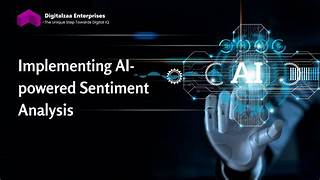AI-Driven Sentiment Analysis in Social Media Platforms: Understanding the Pulse of Public Opinion
Social media platforms have become vital arenas for communication, self-expression, and opinion sharing. From businesses gauging customer feedback to governments monitoring public sentiment, the vast and fast-paced nature of social media presents both opportunities and challenges. Amid this deluge of unstructured data, AI-driven sentiment analysis has emerged as a powerful tool to decipher public opinion, predict trends, and make data-driven decisions.
This article delves into the role of AI-driven sentiment analysis in social media, exploring its mechanisms, applications, benefits, challenges, and the ethical considerations surrounding its use.
What Is Sentiment Analysis?
Sentiment analysis, also known as opinion mining, is a technique that uses natural language processing (NLP), machine learning (ML), and text analysis to determine the emotional tone behind textual data. In the context of social media, sentiment analysis interprets user-generated content to classify it as positive, negative, or neutral.
AI-powered sentiment analysis takes this process a step further by leveraging advanced algorithms that can:
- Detect nuanced emotions like joy, anger, sarcasm, or frustration.
- Understand contextual meanings and slang.
- Adapt to ever-changing linguistic trends on social media.
How AI-Driven Sentiment Analysis Works
The foundation of AI-driven sentiment analysis lies in three main components: data collection, processing, and analysis.
- Data Collection: Social media platforms generate vast amounts of data in the form of posts, comments, tweets, reviews, and hashtags. AI systems use APIs to scrape and aggregate this data, often in real time. This ensures that the sentiment analysis reflects the latest trends and discussions.
- Preprocessing the Data: Before analysis, the raw text must be cleaned and prepared. This involves:
- Removing irrelevant data such as URLs, stop words, and special characters.
- Tokenizing text into smaller units for easier analysis.
- Converting text into a structured format that algorithms can interpret.
- Sentiment Classification: AI algorithms analyze the processed data using various models, such as:
- Rule-Based Systems: These rely on predefined lexicons of positive and negative words.
- Machine Learning Models: These use supervised learning techniques to classify sentiment based on labeled training data.
- Deep Learning Models: These advanced models, such as Recurrent Neural Networks (RNNs) or Transformer-based models like BERT, can understand complex sentence structures and contextual nuances.
- Contextual Understanding: AI enhances sentiment analysis by identifying the context in which a word or phrase is used. For example, the phrase “sick game” could be interpreted as negative in one context but as positive slang in another.
Applications of AI-Driven Sentiment Analysis in Social Media
- Brand Reputation Management: Companies use sentiment analysis to monitor what customers are saying about their products, services, and brand. Negative mentions can be flagged in real time, allowing businesses to address issues quickly and protect their reputation.
- Market Research and Consumer Insights: Analyzing customer sentiment helps businesses understand preferences, identify trends, and anticipate demand. For example, positive sentiments about a new product launch can indicate its potential success.
- Political Campaigns and Public Opinion: Politicians and policymakers use sentiment analysis to gauge public opinion on policies, speeches, or events. This data can guide decision-making and communication strategies.
- Customer Service Optimization: Social media platforms often serve as customer support channels. Sentiment analysis helps identify frustrated or dissatisfied customers so that support teams can respond promptly and appropriately.
- Content Moderation: Social media platforms use sentiment analysis to detect abusive, hateful, or harmful content. This automated detection ensures a safer online environment and reduces the workload of human moderators.
- Trend Prediction and Crisis Management: By analyzing sentiment trends over time, organizations can predict potential crises or shifts in public opinion. For instance, a sudden spike in negative sentiment about a product could signal an emerging issue, such as a defect or a scandal.
- Event Feedback Analysis: Sentiment analysis helps organizers assess public reaction to events, campaigns, or announcements. This real-time feedback can be used to make on-the-spot adjustments or improve future initiatives.
Benefits of AI-Driven Sentiment Analysis
- Scalability: Social media generates massive amounts of data daily. AI-powered sentiment analysis can process and analyze this data at a scale and speed unattainable by manual methods.
- Real-Time Insights: The ability to analyze sentiment in real time is invaluable for responding to crises, tracking campaign performance, or engaging with audiences during live events.
- Enhanced Accuracy: Advanced AI models can detect subtle linguistic cues, including sarcasm, emojis, and slang, resulting in more accurate sentiment classification.
- Cost and Time Efficiency: Automating sentiment analysis reduces the need for large teams of analysts, saving both time and resources.
- Personalization: Businesses can use sentiment data to tailor marketing campaigns, offers, and communication to specific audience segments, improving customer engagement and satisfaction.
Challenges in AI-Driven Sentiment Analysis
- Complexity of Human Language: Social media language is dynamic, often filled with slang, abbreviations, and emojis. Interpreting these nuances accurately remains a significant challenge.
- Sarcasm and Ambiguity: Sarcasm and ambiguous phrases can lead to misinterpretation. For example, a comment like “Great, another update that breaks everything” might be misclassified as positive without contextual understanding.
- Cultural and Regional Differences: Words and expressions can have different meanings across cultures and regions. AI models must be trained on diverse datasets to ensure accuracy.
- Bias in AI Models: AI algorithms can inherit biases from the training data, leading to skewed sentiment analysis results. For example, certain words associated with marginalized groups might be unfairly flagged as negative.
- Data Privacy Concerns: The collection and analysis of user-generated content raise privacy concerns. Users may feel uncomfortable with the idea of their posts being monitored and analyzed without their explicit consent.
- Over-Reliance on Automation: While AI can analyze sentiment effectively, it may miss the depth and context that human analysts provide. Combining AI insights with human judgment is essential for comprehensive analysis.
Ethical Considerations in Sentiment Analysis
- Transparency and Consent: Organizations must be transparent about how they use sentiment analysis and obtain user consent where necessary.
- Avoiding Manipulation: Sentiment analysis should not be used to manipulate public opinion or spread misinformation. Ethical guidelines should govern its application.
- Bias Mitigation: Developers should actively work to identify and mitigate biases in AI models to ensure fair and unbiased sentiment analysis.
- Data Security: Safeguarding user data is paramount. Organizations must implement robust security measures to protect sensitive information.
The Future of AI-Driven Sentiment Analysis
The future of AI-driven sentiment analysis lies in its ability to become even more accurate, context-aware, and accessible. Emerging technologies, such as multi-modal analysis (combining text, images, and videos), will enhance the depth of insights derived from social media data. Additionally, advancements in NLP and ethical AI development will address current challenges and improve trust and transparency.
As social media continues to shape public discourse and influence decision-making, AI-driven sentiment analysis will play an increasingly important role. Whether it’s understanding customer needs, gauging public opinion, or moderating content, this technology is set to redefine how we engage with the digital world.
Conclusion
AI-driven sentiment analysis on social media platforms is a transformative tool that helps decode public opinion, predict trends, and enhance decision-making across industries. While challenges and ethical considerations remain, the benefits of this technology far outweigh the drawbacks. As AI continues to evolve, sentiment analysis will become an indispensable tool for businesses, governments, and individuals seeking to navigate the ever-changing landscape of social media. By leveraging its power responsibly, we can create a more informed, connected, and responsive digital ecosystem.


